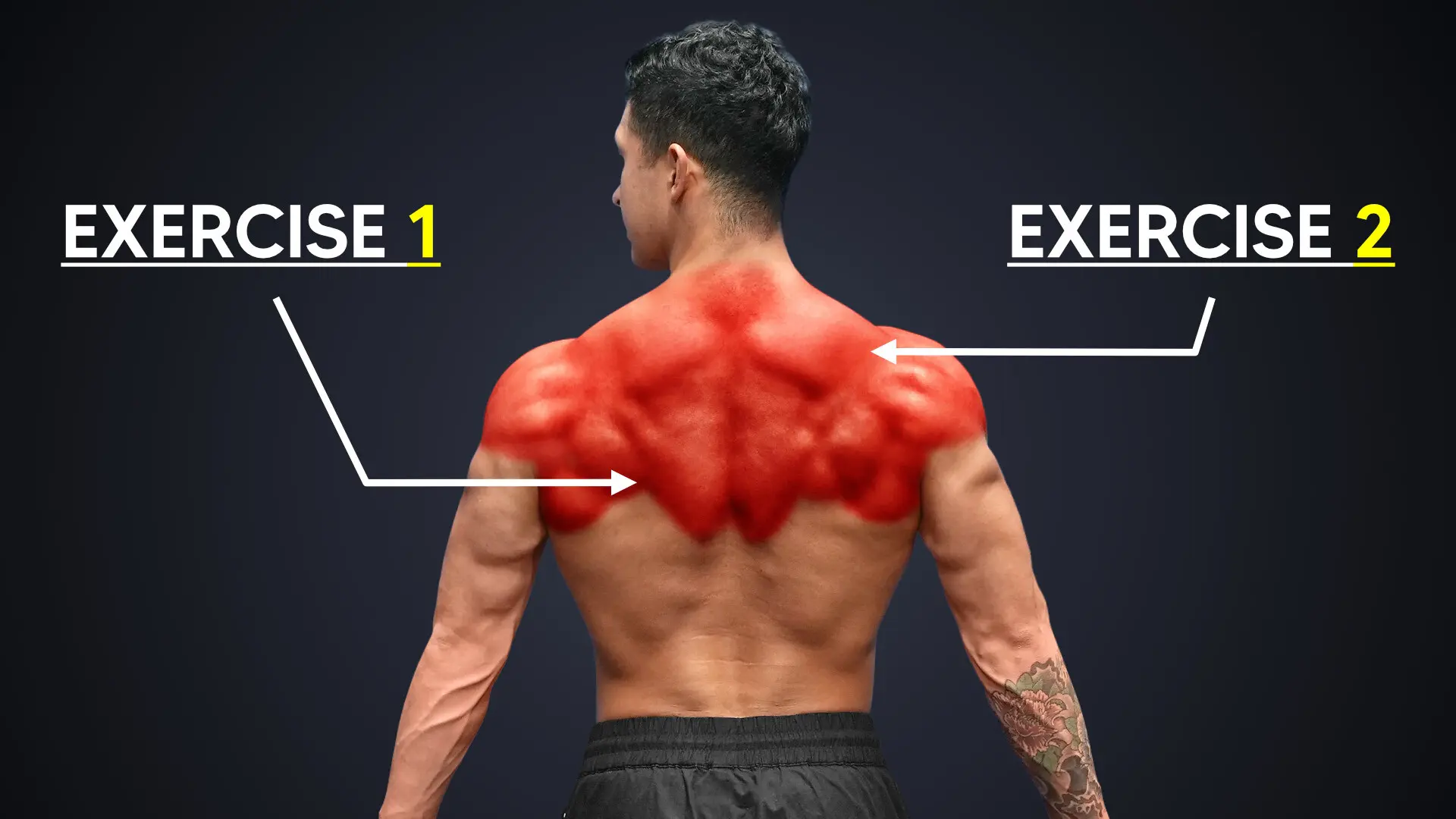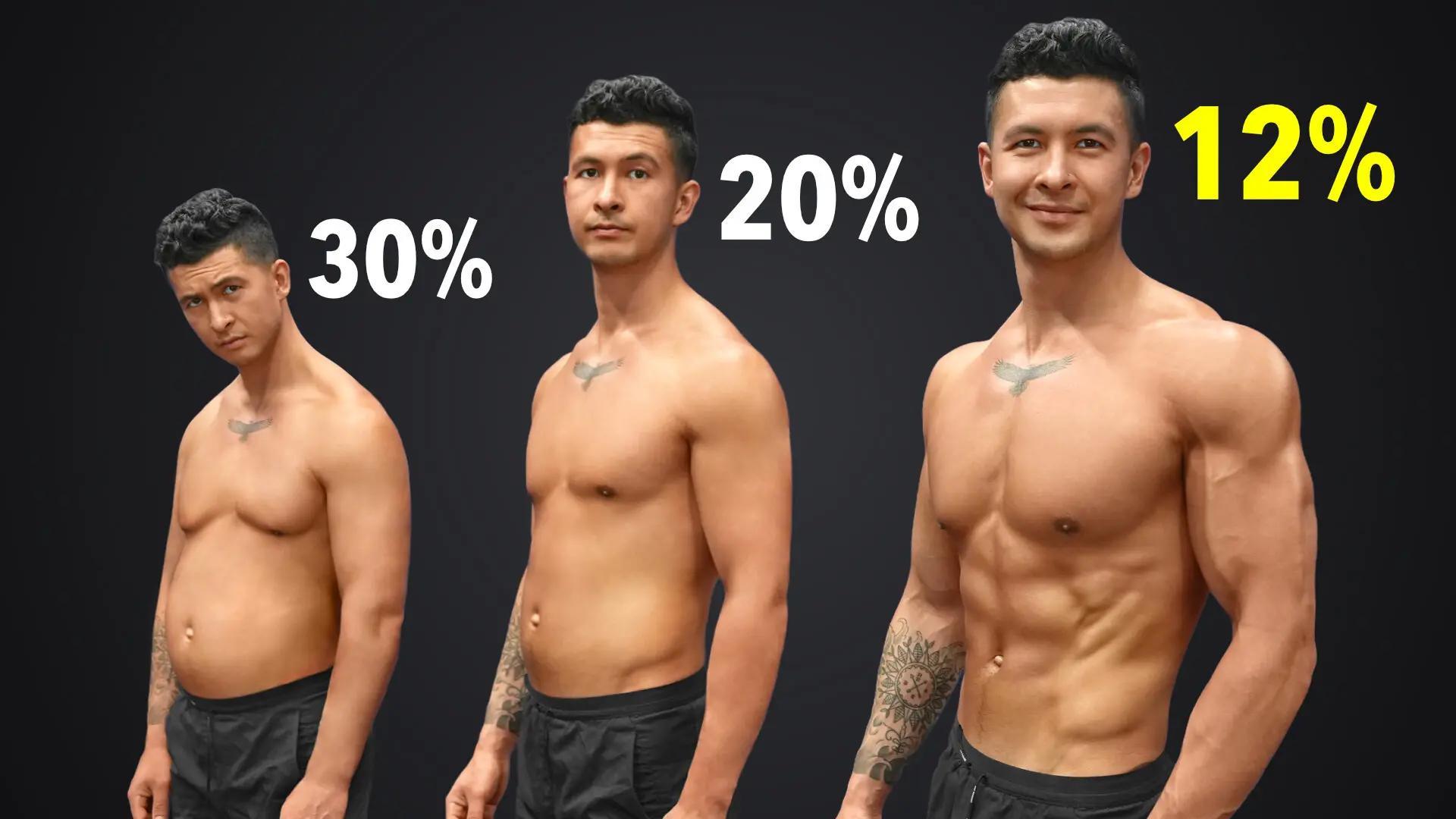
Best Shoulder Compound Exercises in 2023 | Built With Science
Best Shoulder Compound Exercises
Have you ever wanted to wear tank tops, stringers, or go plain shirtless at the gym? But (grudgingly) held back because your shoulders just aren’t ready for that kind of, um, publicity yet?
Well, good news: that’s about to change. Because in this article, I’ll share:
- The 8 best shoulder compound exercises for growing your shoulders
- How to create a routine with those exercises to thicken and widen your delts
- Little-known tips and tricks for maximizing the growth potential of your shoulders
What Are The Best Shoulder Compound Exercises?
First things first. What are "compound exercises", and why should you focus on them?
Simply put, a compound exercise is one that engages multiple muscle groups across multiple joints. A good example is the bench press:
- Prime movers: Chest, shoulders, and triceps
- Joints: Shoulder and elbow joints
The direct opposite of compound exercises is “isolation exercises”. These are single-joint movements that only target 1 muscle group. An example is the lateral raise (muscle: delts; joint: shoulder).
Compound and isolation exercises do equally well at eliciting muscle growth when sets are reps are equated. But compound exercises are often more efficient since you can target multiple muscle groups at once.
Quick example: the chest fly only works the chest. Compare that to the bench press, which mainly works the chest but also the front delts and triceps.
Also, note that compound exercises aren't just great at targeting multiple muscle groups but also tend to activate multiple "heads" within a muscle group.
Take your delts, for example. They’re made up of 3 heads:
- Anterior head (“Front delts”)
- Lateral head (“Side delts”)
- Posterior head (“Rear delts”)
In a previous article, I actually used an EMG machine to determine which shoulder exercises best activated each shoulder head.
If you check it out, you’ll see that the compound exercise, standing barbell shoulder press activated all three shoulder heads relatively well (front: 54.3% MVC; side: 48.4%; rear: 20.2% MVC). This contrasts with the isolation exercise, dumbbell lateral raise, which resulted in pretty good side delt activation (47.4% MVC), but not so much for the others (front: 27.8% MVC; rear: 36.3% MVC).
Meaning? Shoulder compound exercises, like any compound exercises, can give you more muscle growth bang for your buck than isolation exercises.
That said, they aren’t perfect, especially if you're trying to build thick, broad, and wide shoulders. More on that in a sec … but first, let’s talk about what you (most probably) came here for: the top 8 compound exercises for shoulders.
#1: Seated Barbell Shoulder Press
Equipment needed: Barbell, a bench, and ideally a squat rack
Preferentially activates: Front delts
What’s special about this exercise?
In my EMG analysis article, the seated barbell shoulder press ranked second best at activating the front delts (57.3% MVC). This is in line with the findings of a 2020 EMG study published in the Journal of Human Kinetics.
More specifically, the researchers got participants to perform 12 reps at 60% of their 1RM on the following exercises:
- Bench press
- Seated barbell shoulder press
- Dumbbell fly
- Seated dumbbell lateral raise
… and found that the seated barbell shoulder press produced significantly higher front delts EMG values than all the other exercises.
Beyond its knack for activating the front delts, the seated barbell shoulder press also makes progressive overloading relatively more manageable and safer for you than its dumbbell variation (which ranked first at activating the front delts, by the way).
That’s because instead of having to kick heavy dumbbells up to your shoulders, you could simply:
- Set up your bench right underneath a squat rack
- Get your shoulders under the barbell, and
- Lift it off the rack (while ensuring that your wrists and elbows stay stacked)
Here's a critical form tip to remember for all pressing movements: press in the scapular plane. This means keeping your arms and elbows at ~20 to 30 degrees in front of you — relative to your torso — instead of directly to your sides — as you lift.
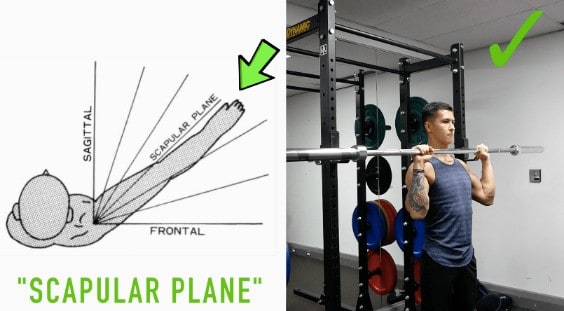
In addition to better lining the tension up with the muscle fibers of your front delts, the scapular plane is generally a safer position for your shoulders.
#2: Seated Dumbbell Shoulder Press
Equipment needed: Dumbbells and a bench
Preferentially activates: Front delts
What’s special about this exercise?
As mentioned earlier, the seated barbell shoulder press came in second best at activating the front delts. So … guess which came in first?
Yep, that’s right: the seated dumbbell shoulder press.
While the exercise can admittedly become increasingly challenging to progressive overload, it has 3 significant advantages over its barbell counterpart. It may:
- Potentially make it easier for you to press in the scapular plane while keeping your hands and elbows stacked (compared to the barbell, which forces you into a fixed hand position).
- Discourage muscular imbalances since each side of your delts would have to work independently.
- Achieve a deeper stretch of your front delts at the bottom position, which a growing body of research (e.g., this, this, this, and this) has shown could result in more hypertrophy.
Once again, remember to press in the scapular plane.

Now, at this point, you may be wondering why I only included seated shoulder press options. Is there something wrong with standing?
Well, not really. Just look at the front delt activation EMG readings I got:
- Seated dumbbell shoulder press: 62.4% MVC
- Standing dumbbell shoulder press: 56.8% MVC
- Seated barbell shoulder press: 57.3% MVC
- Standing barbell shoulder press: 54.3%
They’re comparable.
But if you’re interested in getting the most shoulder gains possible, I’d say it makes sense to skip the standing options because they require more stability (e.g., from your core and glutes) and could, in turn, limit the amount of weight you can use in the long-term.
#3: 45-Degree Incline Dumbbell Bench Press
Equipment needed: Dumbbells and a bench
Preferentially activates: Front delts
What’s special about this exercise?
Wait a minute … incline dumbbell bench press? For the front delts? That’s right.
While you’d typically think of the incline dumbbell bench press as a “chest exercise”, you can preferentially target your shoulders (to be specific, your front delts) by increasing the angle of the incline on your bench.
To illustrate this, let's bring up front delts vs. upper chest activation numbers from another EMG-based article I did to determine the best chest exercises:
| Exercise | Front delts activation (% MVC) | Upper chest activation (% MVC) |
| 15-degree incline dumbbell press | 44.2% | 60.9% |
| 30-degree incline dumbbell press | 54.4% | 58.9% |
| 45-degree incline dumbbell press | 57% | 47.6% |
So, if you’re looking for a shoulder compound exercise that’ll activate your front delts incredibly well, but isn’t an overhead press, give the 45-degree incline dumbbell bench press a go.
Oh, and of course, feel free to switch out the dumbbells for a barbell if you prefer.
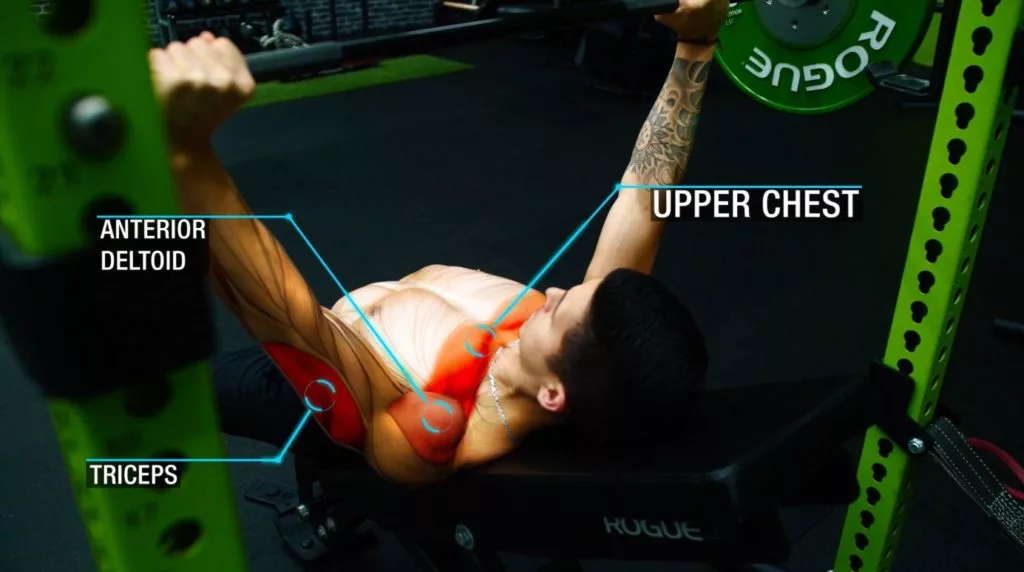
#4: Kneeling One-Arm Landmine Press
Equipment needed: Landmine base and barbell (note: if you don’t have access to a landmine base, you could jam the barbell into a corner of a wall or machine)
Preferentially activates: Front delts
What’s special about this exercise?
If you tend to experience shoulder pain during overhead pressing movements, the kneeling one-arm landmine press is an excellent alternative for targeting your front delts.
It’s not simply more comfortable for your shoulders, either. It’s also great at:
- Preventing muscular imbalances (because it’s a unilateral exercise)
- Building scapular strength and stability, which is crucial for proper and healthy shoulder function
- Improving core stability as it’ll have to work hard to prevent your torso from rotating too far to the loaded side

#5: Wide Grip Upright Rows
Equipment needed: Barbell
Preferentially activates: Side delts
What’s special about this exercise?
Honestly, there are very few compound shoulder exercises that help target the side delts.
But that doesn’t mean there aren’t any.
Case in point: the wide grip upright rows. In my shoulder EMG analysis article, for example, I found that it resulted in the EMG reading of 37.7% MVC in the side delts.
For reference, the dumbbell lateral raise — an isolation exercise considered the G.O.A.T at targeting the side delts — led to a reading of 47.4% MVC. The wide grip upright rows also did pretty decently targeting the front and rear delts, with EMG readings of 20.6% MVC and 29.9% MVC, respectively.
In a way, you could think of the wide grip upright row as one of the best shoulder exercises in general.
All in all, the results I got in my EMG analysis support a past 2014 EMG study which found the upright barbell row to result in the following activation patterns in the participants:
- Front delts: 32% MVC
- Side delts: 73% MVC
- Rear delts: 31% MVC
Now, contrary to popular belief, upright rows don’t necessarily have to hurt your shoulders. There is a much safer way to perform them; here’s how:
- Widen your grip to about 2x shoulder width.
- Raise your elbows only up to the level of your shoulders.
- Ensure that your hands are level with your elbows (instead of below them) at the top position.

#6: Cable Wide Grip Rear Delt Row
Equipment needed: Cable machine
Preferentially activates: Side and rear delts
What’s special about this exercise?
If you want truly impressive-looking shoulders, you cannot forget about your (typically underdeveloped) rear delts.
They help add thickness and that overall 3D look to your shoulders. Beyond the aesthetics factor, research also shows that your rear delts play an important role in boosting shoulder stability and lowering your risk of injury.
And one of the best shoulder compound exercises that’ll help target them?
It’s none other than the cable wide grip rear delt row, which led to the following readings in, yep, once again, my shoulder exercise EMG analysis article:
- Side delts: 25.3% MVC
- Rear delts: 56.8% MVC
Now, here are 2 form tips that’ll help you maximize your rear delts involvement in the cable wide grip rear delt row:
- Ditch the narrow V-bar attachment; use the wider handle attachment like the lat pulldown one instead.
- Grip the bar wide enough such that you're able to pull your elbows back behind your body at a 45-degree angle (relative to your torso) — this helps you line up the tension with the muscle fibers of your rear delts.
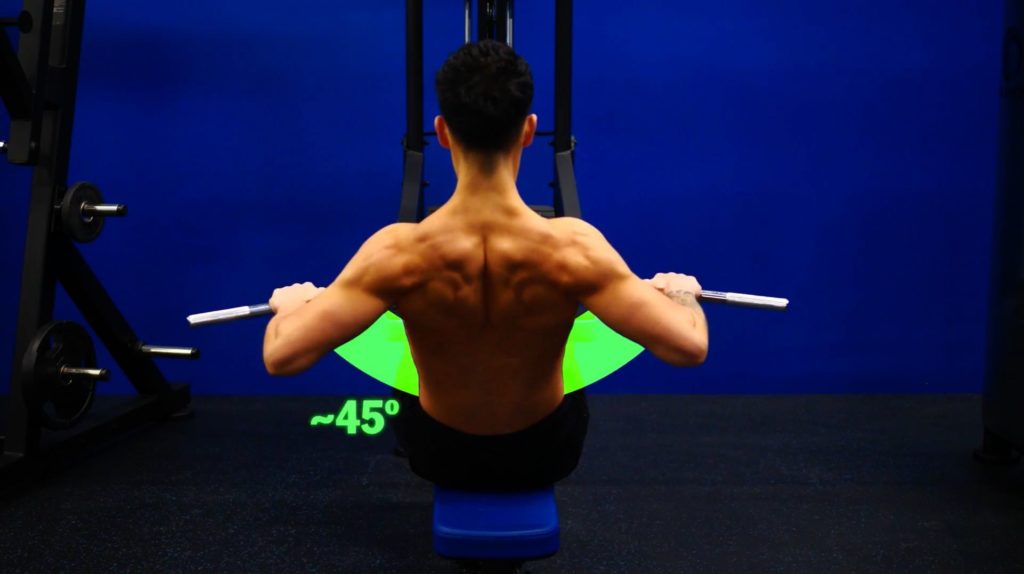
#7: Chest-Supported Dumbbell Rear Delt Row
Equipment needed: Dumbbells and a bench
Preferentially activates: Side and rear delts
What’s special about this exercise?
As with the cable wide grip rear delt row, the chest-supported dumbbell rear delt row works great at activating your rear delts (55.9% MVC) and does OK-ish targeting the side delts (22.4%), too.
Here are a few tips that’ll help you get the most out of this exercise:
- Set your bench to an incline of about 30 degrees.
- Make sure to pull your elbows back as far as you can and at a 45-degree angle relative to your torso.
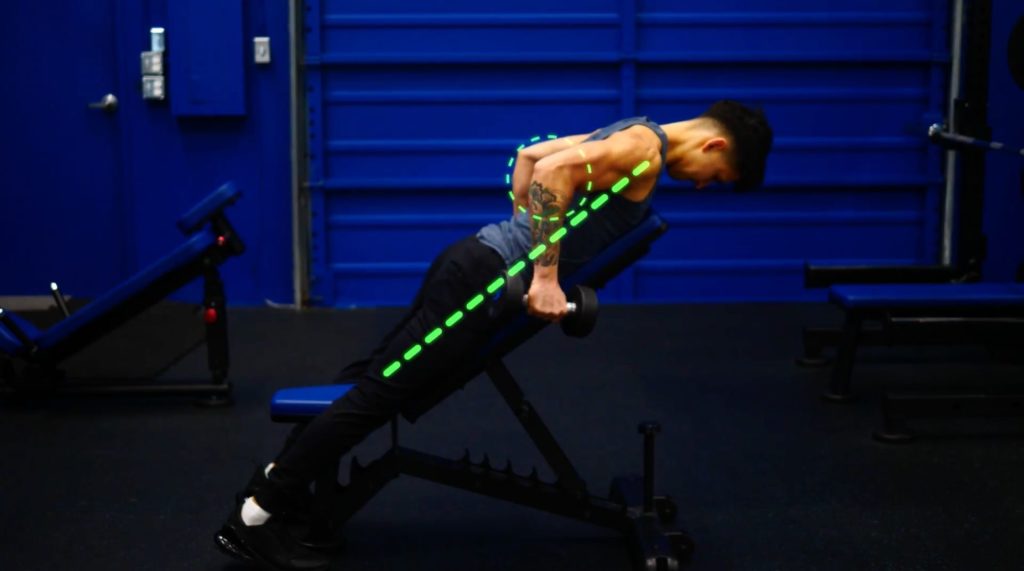
#8: Pike Push-Ups
Equipment needed: N/A
Preferentially activates: Front delts
What’s special about this exercise?
Don’t have access to the gym? Then give the pike push-ups a go.
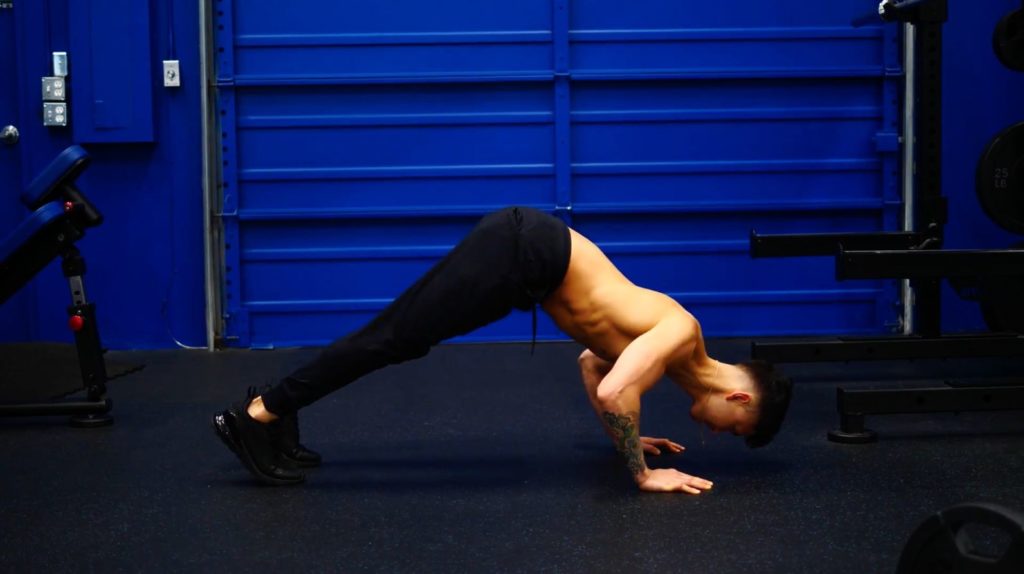
In my shoulder exercise EMG analysis, I didn't test the pike push-up specifically, but I did find out that bodyweight push-ups led to decent activation in the front delts (37.4% MVC on average).
So, theoretically speaking, since pike push-ups mimic the overhead pressing movement, they may result in even higher front delts activation than regular push-ups.
To perform them:
- Start out in a push-up position.
- Move your hands closer to your feet while keeping your legs straight until your body makes an upside-down V shape.
- Then, simply bend your elbows and lower your upper body until the top of your nose nearly touches the floor.
- Press up using your shoulders to return your hands back to the top position.
Of course, pike push-ups aren’t — and shouldn’t be — the only bodyweight exercises you should do to grow your shoulders. For more inspiration, check out this past article I wrote on some of the best exercises you could include in your at-home shoulder workouts.
Is Shoulder Press A Compound Exercise?
Yes, it is a compound exercise.
In fact, all variations of the shoulder press (e.g., standing, seated, barbell, or dumbbells) are considered compound exercises because they work multiple muscle groups across multiple joints.
Do You Have To Do Compound Exercises For Shoulders?
No, strictly speaking, you don’t have to do compound exercises for the shoulders to see optimal growth.
It's just that compound exercises help you target more muscle groups — and even "heads" within any one muscle group — at the same time. So they're more "efficient" in that sense.
That said, if you’re like most people, you’d likely already have overdeveloped front delts (compared to your side and rear delts) from all the pressing movements you do. In this case, you’d likely benefit from focusing on compound exercises that target the side and rear delts.
As you should know by now, that would be the wide grip upright rows, cable wide grip rear delt rows, and chest-supported rear delt row.
But those aren’t the only exercises you should do for wider, thicker shoulders. More on that later.
Sample Shoulder Workout Routines
Here are 2 ways you could put those compound exercises for shoulders together for your shoulder workout in the gym:
#1: Seated barbell shoulder press (3 sets, 8 to 12 reps)
#2: Wide grip upright rows (3 sets, 8 to 12 reps)
#3: Chest-supported dumbbell rear delt row (3 sets, 10 to 15 reps)
#1: 45-degree incline barbell bench press (3 sets, 8 to 12 reps)
#2: Wide grip upright rows (3 sets, 8 to 12 reps)
#3: Cable wide grip rear delt row (3 sets, 10 to 15 reps)
Do A Mix Of Compound And Isolation Exercises
Here’s the thing.
Sure, as highlighted in this article, shoulder compound exercises can target all 3 deltoid heads. Take the wide grip upright rows, for example. It led to a 37.7% MVC in the side delts — which is not bad.
But is it the best? Not at all.
For proof, just look at the side delt activation EMG readings from the following isolation exercises:
- Dumbbell lateral raise: 47.4% MVC
- Lying incline lateral raise: 43.7% MVC
- Cable lateral raise: 41.8% MVC
And you’ll see the same thing when it comes to the rear delts.
The cable wide grip rear delt row (56.8% MVC for the rear delts) wasn’t the top exercise for rear delts activation. In fact, it was outranked by these isolation exercises:
- Cable rear delt flyes (double arm): 70.2% MVC
- Cable rear delt flyes (single arm): 59.9% MVC
- Reverse pec deck machine: 59.3% MVC
Meaning? If you’re interested in maximizing your shoulder gains, you should incorporate a good mix of compound and isolation shoulder exercises in your workout routine.
Isolation exercises are particularly crucial to do for your side and rear delts.
That’s because, as mentioned earlier, in most cases, your front delts are likely overdeveloped from your chest pressing movements.
Adding isolation exercises such as the dumbbell lateral raise and cable rear delt flyes (double arm) to your training plan could really bring up your lagging side and rear delts by helping you accumulate more volume while minimizing stress on your joints.
Take Care Of Your Nutrition, Too
Also, note that training isn’t the only important factor that’ll determine muscle growth.
There’s also your nutrition. You need to eat enough to give your muscles what they need to grow.
See, according to a 2022 meta-analysis published in the Scandinavian Journal of Medicine & Science in Sports, the researchers concluded that a calorie surplus is likely necessary to maximize hypertrophy.
To find out exactly how many calories you should eat, a good guideline (as mentioned in this past article on the best muscle-building diet) is to multiply your body weight in lbs by 15 and then add 200 to 400 calories to this.
Beginners should aim for the higher end (e.g., 400 calorie surplus), while intermediate lifters should aim for the lower end (e.g., 200 calorie surplus).
That said, if you want to build impressive-looking shoulders (and your dream physique overall), optimizing your calorie intake is just the beginning. There's also protein intake, macronutrient distribution, … *deep breath*, and we haven’t even talked about workout programming.
If you’re already feeling overwhelmed, don’t worry. There’s help available. Every Built With Science program shows you exactly how to eat, train, and recover (in a step-by-step manner) to transform your physique in the most time-efficient way possible. To discover the best science-based program for you and your body, just take my free analysis quiz below:
Click the button below to take my analysis quiz to discover the best program for you:
↓



